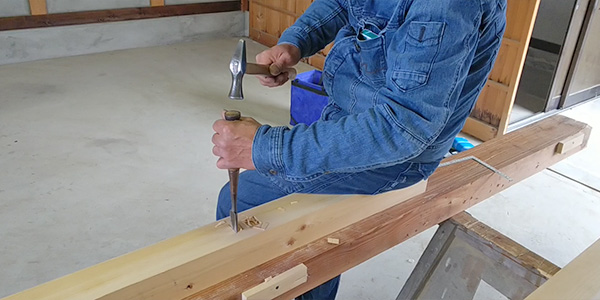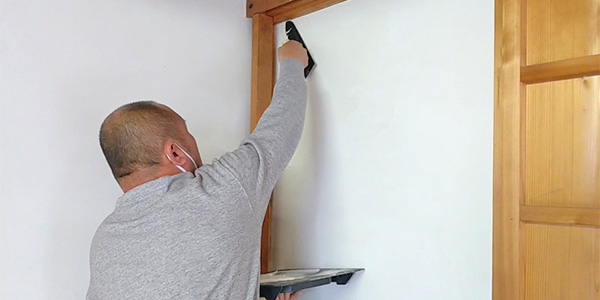CRAFTMANSHIP
Mission to pass on the skills of traditional Japanese architectural craftsmen to future generations
Traditional Japanese houses or “Kominka” that have been built for a long time require "revitalization = renovation." Unlike typical residences, renovating these houses, which were constructed using specialized techniques, necessitates expertise in traditional Japanese architecture. Only skilled craftsmen with specialized knowledge can undertake this task. In order to pass on culturally valuable Kominka to the next generation, the presence of craftsmen with expertise in traditional Japanese architecture is essential.However, in recent years, factors such as the aging of craftsmen, a shortage of successors, and a decline in the number of old houses have led to a drastic decrease in the number of craftsmen.
As a company dealing with Kominka, we aspire to pass on the skills of craftsman with traditional Japanese building techniques to the next generation.
The Techniques of Traditional Japanese Architecture Craftsmen
Now, let us introduce an example of the skills of traditional Japanese craftsmen.

Carpentry Techniques:
In constructing old traditional houses, known as "Kominka," craftsmen assemble buildings without using nails, relying instead on the precise combination of wooden components. Craftsmen skillfully use traditional tools such as "nomi" and "kanna" to shave the wood, ensuring a perfect fit between the wooden pieces. This delicate work leaves no room for even the slightest deviation.
In modern construction, wood is often pre-cut in factories, and the assembly on-site is akin to putting together a model. Since specialized skills are not required for on-site craftsmen, they lack the expertise in crafting these types of wooden structures.
In constructing old traditional houses, known as "Kominka," craftsmen assemble buildings without using nails, relying instead on the precise combination of wooden components. Craftsmen skillfully use traditional tools such as "nomi" and "kanna" to shave the wood, ensuring a perfect fit between the wooden pieces. This delicate work leaves no room for even the slightest deviation.
In modern construction, wood is often pre-cut in factories, and the assembly on-site is akin to putting together a model. Since specialized skills are not required for on-site craftsmen, they lack the expertise in crafting these types of wooden structures.

Plastering Techniques:
Craftsmen called "sakan" finish walls in Kominka by applying plaster with dedicated tools. The techniques of blending materials according to the day's temperature and humidity, as well as the skill of smoothing the walls with tools, cannot be acquired overnight.
With the decrease in the number of traditional Japanese-style rooms in homes and the prevalence of wallpapered walls, younger plasterers, in general, have less experience in the actual act of "plastering." They often lack exposure to the distinctive interior features of old houses, such as "juraku"(clay walls), "tsuchikabe" (earthen walls), and "urushi" (lacquer).
Craftsmen called "sakan" finish walls in Kominka by applying plaster with dedicated tools. The techniques of blending materials according to the day's temperature and humidity, as well as the skill of smoothing the walls with tools, cannot be acquired overnight.
With the decrease in the number of traditional Japanese-style rooms in homes and the prevalence of wallpapered walls, younger plasterers, in general, have less experience in the actual act of "plastering." They often lack exposure to the distinctive interior features of old houses, such as "juraku"(clay walls), "tsuchikabe" (earthen walls), and "urushi" (lacquer).
Interview with a Carpenter
We would like to introduce an interview with a carpenter involved in wood processing, highlighting the splendid nature of traditional Japanese architectural techniques and the expertise gained through years of experience.―In what aspects does experience come into play?
Experience is crucial in adjusting the approach to wood processing based on factors such as weather conditions, wood moisture, daily humidity, wood type, and whether the wood is new or old. For instance, on a humid day, the wood may be easier to shave, and the sense of working with new wood versus old wood differs due to varying levels of dryness. These judgments are made using the cultivated "craftsman's intuition" developed over the years of experience.―Acquiring the skill takes a considerable amount of time, but how long exactly?
The condition of Kominka varies greatly. It takes around 10 years not only to master the techniques but also to develop the knack of figuring out how to handle different situations. While simple processing based on instructions may take a shorter time, understanding the entire picture of a Kominka requires more.―Is it not possible to revitalize Kominka with just the skill of processing?
No, it's not possible. Essentially, one must understand the structure of the old house. Knowledge is needed about where to use specific types of wood, the required size of the wood, whether the wood's lifespan is sufficient, and the sequence in which to assemble the wood. Most young carpenters who have learned the prevalent prefabrication methods in modern construction lack both the processing skills and this kind of knowledge.Interview with a Plasterer
Next, we present an interview with a plasterer who engages in the task of plastering the walls of Kominka using traditional materials.―In what aspects does experience come into play?
The process of thinly and evenly plastering the walls of old houses with traditional plastering materials relies entirely on intuition. Depending on the stickiness of the materials used, the motion when troweling differs, and the technique varies between applying plaster in wide areas versus narrow ones. The pressure applied also differs based on the materials used.Moreover, the choice of materials requires adjusting the mixture with water, taking into account factors such as climate and the sun exposure of the walls. Without aligning various elements, one cannot achieve the skilled craftsmanship needed.
―Acquiring the skill takes a considerable amount of time, but how long exactly?
Among our colleagues, the most skilled artisan is a 75-year-old craftsman. Even someone with 16 years of apprenticeship may not be able to perform at the same level as the most skilled artisan.Currently, there is a sharp decline in traditional Japanese architectural craftsmen, and the skills are at risk of disappearing.

The pinnacle of craftsmanship, as introduced above, is evident in globally renowned temples such as Kyoto's "Kiyomizu-dera," "Kinkaku-ji," and the revered "To-ji," which Microsoft's Bill Gates expressed a desire to own. Craftsmen involved in the construction and restoration of World Heritage sites, designated national treasures, and other culturally significant buildings, including temples and shrines, are referred to as "miyadaiku" (temple carpenters). Their skills are crucial in supporting traditional Japanese architecture. Craftsmen working on our company's Kominka revitalization projects also possess solid expertise, having been involved in the restoration of temples and shrines.
However, these craftsmen are facing a crisis as their numbers have drastically decreased in the 2020s, and the skills are on the verge of extinction.
One reason for the sharp decline is the aging of craftsmen and the shortage of successors. Cases where the youngest among colleagues is in their 60s are not uncommon, and the transmission of skills to the next generation is at a critical point. This is due to the extremely long time, over ten years, required for the inheritance of these skills.
The most significant reason is the decrease in the number of Kominka itself. Despite the potential for well-maintained Kominka to last over 100 years, many are left vacant, neglected, and eventually demolished. Unlike in Western countries where old structures are cherished and used for an extended period, the current trend in Japan involves frequent demolition and reconstruction of modern-style homes, contributing to the disappearance of workplaces for traditional Japanese architectural craftsmen.
Training craftsmen is our company's mission.

Because we specialize in dealing with Kominka, we aim to break the current trend and pass on artisan skills to the next generation. To achieve this, we have implemented various initiatives.
For example...
To promote our expertise not only within Japan but also internationally, we conducted research trips to the United States. We invited Japanese carpenters living in the United States to Japan and provided training in the authentic techniques of revitalizing Kominka.
For example...
To shorten the period of technical transmission to successors, we experimented with the use of cutting-edge IT technology (such as motion capture) to visualize the skills of adept craftsmen.
Moreover, we believe that the most effective way to pass on skills is for our company to undertake more projects related to Kominka revitalization. By providing craftsmen with on-site opportunities, we can increase job opportunities and create a platform for craftsman training. Continuing our efforts in Kominka revitalization allows craftsmen to grow, ensuring the inheritance of skills to the next generation. We consider preserving and passing on these skills through such a positive cycle as a significant mission of our company.

